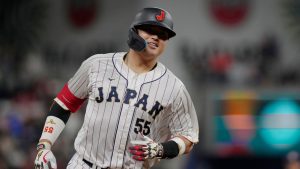TORONTO — Before we deep dive into the latest word salad sliced and diced by Ross Atkins during a 20-minute discussion with media, let’s look at the tailored messages to three specific audiences delivered by the Toronto Blue Jays general manager.
First, to fans, he acknowledged that the team had put itself “in a tough spot” but refused to wave a white flag on the season just yet, insisting that “we're going to try to correct it.” He also signalled that there are no plans for a deeper teardown, vowing that the goal is to build “the best possible team that we can and continuing to extend that (competitive) window as long as we can.”
Second, to his players, there was a push to keep fighting, saying, “we really need to, one day at a time and one pitch at a time, get things turned around to be in a position to buy,” adding that “we still feel like this is a team that if we can get into the playoffs is built well for it with our ability to make consistent contact, play great defence and have good pitching.”
Lastly, to the other 29 teams ahead of the July 30 trade deadline, there was an important signal of the club’s intentions — for now we’re not selling, but be ready in case we do.
“We're prepared to take two different angles ... or really three. But the coming days are exceptionally important to us,” Atkins said Thursday before the Blue Jays throttled the AL East leading New York Yankees 9-2 in the opener of a four-game series. “Understanding the market is also exceptionally important to us either way. We're focused on winning. We're focused on building the best possible team we can this year, supporting them the best possible way we can. If we get to a point where we need to adjust, we'll be prepared to do so.”
Atkins didn’t want to state what those angles would be in what could be taken as “black or white” terms, so we’ll cut through the murk and, for clarity’s sake, call it buy, hold or sell. He also dodged attempts to pin him on the thresholds that would force an adjustment and on what an adjustment might look like.
And to be fair, at this point in his run as GM, with the franchise in precarious position due to a position-player group that’s quickly timing out and a farm system lacking the depth to replenish it, that call is really above his paygrade.
Realistically, the looming decisions on core trajectory, strategic direction and assessment of organizational performance belong on the desk of CEO and president Mark Shapiro, who the club is only planning to make available to media sometime in August.
As such, Shapiro is attempting to reinforce that Atkins will oversee the Blue Jays through this pivotal trade deadline, while also avoiding any public comment that could tie his hands once the dust settles and the club has picked its lane.
So, when Atkins said, “the fact that we are in this position squarely lies with me, I'm accountable for that,” the lack of public direction to the fanbase from Shapiro positions him to hold his GM to that.
For the time being, though, the Blue Jays are keeping all their options open, hoping for a low-probability outcome — FanGraphs calculates their playoff odds at 5.9 per cent after the win over the Yankees — that allows them avoid a sell-off.
It’s a decidedly middle-ground approach that this front office also employed after the 2016 season, with an aging roster coming off consecutive trips to the American League Championship Series.
Following that ALCS loss to Cleveland, the Blue Jays didn’t double-down on their group, failed to re-sign Edwin Encarnacion, replaced him with lower impact players like Kendrys Morales and Steve Pearce, and meandered their way through a lost season. The same thing happened after the 2017 campaign, when Randal Grichuk, Aldemys Diaz and Yangervis Solarte were their key adds, they never were in contention and by the time they began trading off assets, their values had began to diminish and they weren’t able to maximize the return.
While it was understandable at the time given the excitement the 2015-16 runs had created, there’s a lesson to be drawn from holding on to players too long without a strong enough foundation to fully leverage them.
In that way, as much as the Blue Jays need to think about 2024 right now, they also need to be thinking about 2026 with nine players potentially eligible for free agency after 2025.
“It's interesting. You look at successful organizations that have gone through five and six year rebuild processes and timelines and we made the decision ... coming into the '16 season not to do that,” said Atkins. “And ‘16 was a successful year and then tried to continue that based on a very strong roster and it didn't work. We weren't as successful as we hoped to be. Pivoted to making some trades, were able to, in three years, turn things around to a winning team and sustain that for four. Still feel like this is a good group that we'll continue to build upon. The lessons that we've learned aren't as specific to the question that you ask and I think they're a little bit more nuanced and maybe for another day to talk about.”
Or maybe not, as those 2017-18 teams are cautionary tales to be wary of.
The worst position to be in during the final days before July 30 is in the muddled middle ground, close enough to a wild-card spot that it’s hard to sell, but distant enough to not be confident about ending up on the right end of things after 162.
If the Blue Jays’ farm system was deeper, they would have more flexibility to take a risk. But holding on to valuable deadline assets like Yusei Kikuchi and, if healthy, Yimi Garcia only to not reach the post-season and then watch them walk out for nothing is negligent.
And so, the current hedge.
“We're always focused on winning. Right now our focus is on the '24 team. And with every decision that you make, regardless of stadium renovation or the state of your organization, you have to be thinking about the future, as well,” said Atkins. “But as you've seen over the last four years, we've poured a lot into the current situation, the current team and from a financial standpoint, from a trade standpoint, from a resource standpoint, we'll continue to do that, until it doesn't make sense to do so anymore for us.”
The Blue Jays have 4½ weeks to decide whether it still makes sense or not. One way or the other, the even bigger questions follow immediately after.






